I can count three days among my favorites of 2023. There was April 23, when my buddies Nick Cardillo and Sergio Angelini competitively collaborated with me to put together our list of The Thirteen Best Alfred Hitchcock Movies of all time. Nobody came to blows – it helps to put several thousand miles between you when you engage in such important work – and we had such a good time that we returned to the table on October 9 to draft our Top Twenty Agatha Christie Novels. That was was fairly copacetic – although whenever Sergio or I want to wound each other, he mutters “Murder Is Easy” in my ear, and my returning salvo is “By the Pricking of My Thumbs,” for neither of these respective personal favorites made the list!
Our process follows the format of one of my favorite podcasts, Screen Drafts, which you should be listening if you like films and especially like hearing people who are passionate about films talk about them. After one home game edition of a film draft and one literary equivalent, we decided to return to the movies. Nick, as some of you may know, is an avid Sherlockian, having even written his own pastiches of the Great Detective. We decided to head into Doyle-ian territory via old Hollywood and do a Super Draft of the fourteen films Sherlock Holmes film made between 1939 and 1946 that starred Basil Rathbone as Holmes and Nigel Bruce as Dr. Watson. Darryl Zanuck over at 20th Century Fox reluctantly got the ball rolling with an adaptation of The Hound of the Baskervilles. He was so unconvinced that a Holmes movie could be successful that he gave top billing to Richard Greene as Sir Henry Baskerville and really pushed the romance in the film with Wendy Barrie’s character.
Zanuck needn’t have worried: the chemistry between Rathbone and Bruce crackled onscreen. The film was a big success, prompting Fox to greenlight a sequel, The Adventures of Sherlock Holmes. And then – they quit! Fortunately, Universal expressed interest, and Rathbone and Bruce went on to make twelve more pictures as the world-famous detective duo. The only caveat: Universal decided to place our pair in modern-day England and send them off to fight the Nazis!!! Universal sought to explain it all away with a title card at the start of the first film:
“Sherlock Holmes, the immortal character of fiction created by Sir Arthur Conan Doyle, is ageless, invincible, and unchanging. In solving significant problems of the present day, he remains – as ever – the supreme master of deductive reasoning.”
And you know what? For the most part, Holmes and Watson indeed proved themselves to be timeless, especially after the Nazis were set aside in favor of more atmospheric films. Not that the studio didn’t make the most of Holmes as a propaganda tool: at the end of these films, Rathbone as Holmes would deliver a stirring speech to Bruce-as-Watson, using the words of Doyle himself, or Churchill or Shakespeare, to galvanize public support for the war effort. That, and a final shot asking everyone to BUY WAR BONDS, did what it was meant to do! But as the series continued, one could see the exasperation growing on Rathbone’s whole demeanor. Between the films and a highly successful radio series, he was sick to death of Holmes and would go on to blame the character for ruining his career! The film series came to an end, and Rathbone would retire from the radio series as well. Nigel Bruce went on for another year with Tom Conway (the brother of actor George Sanders) taking over as Holmes. Bruce would resign after that season, and a series of substitutes kept the series going for a few more seasons – but it would never be the same.
Sergio, Nick and I sat down for five hours on Saturday, December 30, and drafted our list of the Rathbone-Bruce Holmes films from worst to best. Here are the results.
* * * * *
The first thing we needed to come up with was a drafting order. This is a serpentine draft where the three players each take turns coming up with a title in order to create our “best of” list. Each position is given certain advantages and “blessings,” as follows:
DRAFTER C – selects films at positions 14, 13, 10, 6, and 3. That’s five films, but they are weighted toward the bottom of the list. As for blessings, C gets a veto to start with, as well as a veto override.
The veto means that if a person plays a film and a player disagrees with that placement, he can veto that selection and force the drafter to come up with another title. Since we are drafting all fourteen of the Sherlock Holmes films, the only reason to veto another person’s choice would be to move that title higher up on the list.
The veto override is used if a person vetoes another person’s selection but the person with the override agreed with the original choice. Playing the override makes that veto worthless.
DRAFTER B – also gets five picks: 12, 9. 8, 5, and 2. B gets a veto but no extra blessing. However, in a Super Draft like this, B potentially has the power to determine the final #1 selection. It all depends on how the blessings are played!!
DRAFTER A – selects films at positions 11, 7 4, and 1. That’s only four picks, but they are top picks. And to sweeten the pot, Drafter A is given an extra veto.
Drafting order is determined through a round of trivia. Since we are a non-hosting trio, the way we do trivia is that each player comes up with three questions for the other two players. After all nine questions have been asked, we tally up the answers to see if we have an order. If there’s a tie, we come up with one or two additional questions.
This was our trivia round. Nick asked the first three questions, followed by Sergio, and then Brad. In case you want to play along, I will put the answers at the bottom of the post.
TRIVIA QUESTIONS
- At 74 minutes, this is the longest of the Universal Holmes films.
- In Pursuit to Algiers, Holmes claims that Professor Moriarty was proficient at this woodwind instrument.
- Holliwell Hobbes, who played Brunton in SH Faces Death, originated a pivotal role in which Agatha Christie play.
- Rathbone and Bruce made a cameo appearance in their Holmes characters in which 1943 Universal picture?
- Who wrote the theme music for the series?
- In The Adventures of Sherlock Holmes, what song does Basil Rathbone sing?
- How many times did Professor Moriarty appear in the fourteen-film series?
- Nothing is less suspenseful than a group of villains being portrayed as bumbling fools, as the trio of goons is shown to be in Pursuit to Algiers. One of them, Martin Koslek, who plays the strong man Mirko, later went on to play an equally bumbling villain, this time a general no less, on which 1960’s TV show?
- Listen to this music. https://www.youtube.com/watch?v=2r4TSoLSyAU What is its significance?
The results of the trivia round were that Nick came first with 4 correct answers and chose Drafter B, Sergio came second with 3 correct answers and chose Drafter A. Brad came in third and was left with Drafter C. And with that, we began our draft.
* * * * *
NUMBER FOURTEEN
Brad selected Terror by Night (1946).
Sergio immediately vetoed it.
Brad countered with Sherlock Holmes and the Secret Weapon (1942)
Sergio loves Lionel Atwill as Moriarty and thinks it’s the most fun of the Nazi films; consequently, Sergio used up his second veto.
Brad smiled complacently and put in his third choice: Sherlock Holmes in Washington (1943). This is the worst of the anti-Nazi films, having to do with Holmes and Watson tracking down military plans, which takes them from London to New York and finally to our nation’s capital. It’s not all bad: the opening sequence before Holmes enters the picture is fun, and while Henry Daniell is wasted here as a thug, once George Zucco appears as Nazi boss Heinrich Hinkel, things liven up.
Rathbone seemed to have it in his contract that he gets to put on disguises and show of his acting range. Too often, these moments are ridiculous because it’s impossible to believe that Holmes won’t be recognized. In this film, however, there are no disguises but a chance for Rathbone to do some real acting as an effete antiques enthusiast. One of Brad’s least favorite aspects of these films was how stupid Watson was made to appear. Here, he is at his worst, caring more about cricket scores than fighting the Nazis, and Holmes is most patronizing to him throughout.
Sergio tended to agree, finding the film quite dull. But Nick likes it more, thinking it contains some good spy stuff.
NUMBER THIRTEEN
Brad played The Woman in Green (1945). Inspired by the Doyle stories, “The Empty House”, “The Cardboard Box,” and “The Final Problem,” this feels to Brad more like a 1940’s crime drama that happens to have Holmes in it. He finds it weird seeing Holmes take Inspector Gregson to a nightclub for a cocktail after a hard day at work or feigning sexual chemistry with Hillary Brooke as femme fatale Lydia. Holmes is more of an action P.I. here, and his relationship with Watson seems almost one of pity and fondness for a beloved pet. In many ways, this feels like a retread of another film that Brad likes much more and will surely find itself much higher on the list.
Nick and Sergio both like this one a lot more. For Nick, it boils down to Henry Daniell being his favorite of the Moriartys. He’s so cold and reptilian! Sergio had also placed it much higher, enjoying much more how the story plays with Holmes’ humanity and utilizes elements from the original story. Both players discussed how while it’s a messy movie, it’s wonderfully dark, setting up a nasty Jack the Ripper-type plot – and then unfortunately dispensing with it. In an early draft, the victims were all supposed to be children! The censors forced screenwriter Bertram Millhauser to change it. Sergio loves the grimy feel of the film, and some of the visuals, including the hypnotism FX, are great.
The opening sequence is narrated by Inspector Gregson. Brad wondered why this was so, first because Dr. Watson is one of the most famous narrators in literature and his appearances on the radio show had already begun, and second, because Gregson is quickly reduced to a minor figure and his narration is dropped.
NUMBER TWELVE
For his selection, Nick chose Pursuit to Algiers (1945), the film both he and Sergio agreed should have been at the bottom. In this one, Holmes is hired to protect the young prince of a fictional principality, fakes his death in a plane crash, and then smuggles the prince aboard an ocean liner headed for Algiers. Watson happens to be on that boat as well and assists Holmes in his own feeble-minded way. A trio of assassins boards the ship mid-ocean and repeatedly attempt to assassinate the prince, only to be continually foiled by Holmes. In the end, Sherlock pulls a big bluff and the prince gets safely off the boat and headed to his home country to assume the throne.
For Nick, this film feels like a tax write-off! Its lack of plot feels like a waste of 65 minutes. The young ingenue sits at a piano and sings four times. Every musical number is awful. The only thing that makes it memorable is Holmes’ claim that Moriarty was a virtuoso on the bassoon. This was Sergio’s worst as well: it looks cheap. The boat sets are butt ugly. Rathbone looks sick and tired of playing Holmes (hint: he was!).
Brad couldn’t disagree. At one point, Watson relates the tale of the Giant Rat of Sumatra, which is the story that couldn’t be told. Here, it becomes clear that it would have simply bored readers to death. The villains here are comical in their never-failing ability to fail. Holmes is always aware of every plot, always two steps ahead (how could he know the party cracker was a bomb?) Plus, this has to be the most anti-climactic ending in the canon: three minutes before it ends, the young “king” is kidnapped, after which we learn that 1) he wasn’t the king at all, and 2) he was rescued as soon as the villains docked onshore. What a waste!
NUMBER ELEVEN
For his first pick, Sergio selected Dressed to Kill (1946). The race is on to retrieve stolen plates, the location of which has been embedded in several music boxes by a cunning prisoner. Once again, Holmes faces a femme fatale, played with aplomb by Patricia Morison. It has fun moments, like the gassing scene and a cute ending with Watson taking credit for Holmes’ work. Sergio loves Morison, but a lot of her plan feels like retreads from The Spider Woman. Too much of the film feels like things we’ve seen before. Nick had it at #10. It’s one of the earliest SH films he saw because it’s in the public domain. He loves the first scene where Watson is reading over “A Scandal in Bohemia.” Morison will use things found in this and other stories against Holmes and Watson in clever ways.
For Brad, a lot of Sergio’s complaints mirror his own for The Woman in Green. He placed this one slightly higher. He prefers Morison’s character to Hillary Brooke’s in TWiG, and he loves Morisons confederates, played by Frederick Worlock and Harry Cording, as well as Ian Wolfe as the Commissioner of Police. (NOTE: a lot of the joy in these films comes from watching a company of character actors reappear from film to film in varying roles!) This feels to Brad more like a Sherlock Holmes story, despite being set in the 40’s; the settings – the auction house, 221B, the Limehouse busker’s inn where they sing songs from the olden days – give this a more traditional period feel.
NUMBER TEN
Brad replayed his first pick, Terror by Night (1946). It has touches of “The Adventure of the Empty House” (due to the presence of Colonel Sebastian Moran), “The Adventure of the Blue Carbuncle” (a giant jewel is stolen), “The Disappearance of Lady Frances Carfax, and The Sign of the Four. It’s set on a train – the ugliest “luxury” train set ever – and while it features Dennis Hoey as Inspector Lestrade, it’s quite dull. Even Nigel Bruce, who always brought his A game, looks bored. Despite the presence of a whole bunch of the SH repertory company, none of their roles stand out, except maybe Alan Mowbray, who is one of the least surprising “surprise” villains of them all.
This was Nick’s #13. It’s ludicrous that Watson’s old friend turns out to be the main villain – AGAIN!! Even Holmes being kicked off the moving train feels astonishingly boring. The final 15 minutes with Inspector McDonald are the best part. Sergio, however, placed it much higher; it was his #7. Maybe he’s a sucker for train movies. Given how late it is in the series, it felt like quite good fun. It does feel like the first reel is missing (all the stuff that should have happened in Baker Street to set up a case isn’t there). It was the most expensive film in the series because the studio was hit by a strike in the middle of shooting. Maybe that’s why it looks so cheap; they ran out of money and resorted to tired stock footage.
NUMBER NINE
Nick played The House of Fear (1944).
Brad vetoed it.
Nick came back with Sherlock Holmes Faces Death (1943). Based very loosely on “The Musgrave Ritual,” the film finds Dr. Watson treating shell-shocked soldiers at Musgrave Manor in Northumberland. When another one of the doctors is attacked on the grounds, Watson summons Sherlock Holmes to investigate. The remaining members of the Musgrave family still live in the estate, and they begin dying off one by one. Holmes eventually uncovers the murderer, partly helped by a recreation of the family ritual, which here involves a life-sized game of chess.
Nick loves the Gothic elements (the reuse of Dracula’s crypt as a set, the raven that can smell blood.) For once, Watson gets alone time and feels like a stronger, more competent character. Yet as fun as it is to see Holmes investigate a routine murder case, The murderer is so devoid of personality that his identity as a rapacious egomaniac comes out of nowhere. And the script never explains why the clock chimes 13 times. Sergio was frankly furious at Brad for making this one come out lower than The House of Fear. Brad loved the whodunnit aspects of the film and the inclusion of actual clues, even if the solution was pretty obvious (read 4:50 from Paddington, folks). He simply found himself enjoying this one less on a rewatch and liking The House of Fear more.
NUMBER EIGHT
Brad’s veto didn’t have much effect because Nick immediately replayed The House of Fear. This adaptation of “The Five Orange Pips” follows the original story less than Gladys Knight and her Pips did. A group of single gentlemen have all moved in together at Drearcliffe House, a remote Scottish castle. One by one, the men die horrible deaths, and their only warning is a letter they receive containing the titular pips. Holmes and Watson are hired to investigate and eventually discover an insidious plan based on the grand GAD chestnut of a tontine.
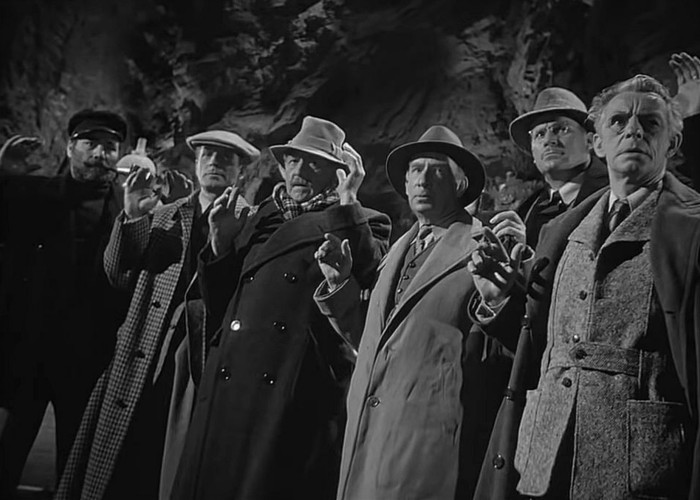
For Nick, the film wants to go in the same nasty direction as The Woman in Green. The murder methods are gruesome (they have to be!). Yet he finds the film overly talky and stagey film, and Holmes doesn’t really do much of anything. It wants to be And Then There Were None and clearly isn’t. It does have a proper Doyle-ian set-up of the client coming to Baker Street and leading Holmes and Watson to a location in order to solve a mystery.
Sergio had this at #11. For once, he brought up Watson’s stupidity: here he behaves at his most infantile when he shoots up the joint. The plot is unbelievably stupid with a twist ending nobody in their right mind would come up with! Brad disagreed pretty much down the line, having placed this as his #3. It is a showcase for the wonderful repertory of players. Paul Cavenaugh shines as the most villainous-seeming of the Good Fellows, and Sally Shepherd steals the show as Mrs. Monteith, the morbid housekeeper. And Brad loves the final twist where (ROT-13) abobql vf ernyyl qrnq naq Ubyzrf raqf hc haznfxvat gur bayl zna jub vf . . . vaabprag!
NUMBER SEVEN
Sergio selected Sherlock Holmes and the Secret Weapon. This is the second of three films where Holmes and Watson battle the Nazis. This time, Professor Moriarty (Lionel Atwill) is working for the Germans and trying to track down the plans for a weapon that the inventor has scattered among four of his scientific colleagues. So we have another example of “The Six Napoleons” idea, combined with “The Dancing Men,” in that there is a code that must be deciphered. Sergio likes all this and feels Atwill made is a good Moriarty; the film also has an exciting ending. Rathbone for once dons a great disguise that fits in with the plot (and he is really good in the part).
Nick disagrees with the popular opinion that this is the best Nazi film. For one thing, it looks worse than Voice of Terror. You feel Rathbone is having fun as Holmes and he revels in the disguises. Nick loves Moriarty’s secret lair with the abacus that uses skulls. There’s a deeply shocking torture scene that stands out in a relatively staid film. And it’s nice to wrap up with Holmes quoting Shakespeare. Brad also likes another of the trio much more and while he appreciates Dennis Hoey’s debut as Inspector Lestrade – at least he’s at his least buffoonish – this is another example of Dr. Watson being played strictly for laughs. Not that Nigel Bruce wasn’t always a delight – here he performs the function of Captain Hastings by inadvertently remarking on something that gives Holmes the key to the case.
NUMBER SIX
Brad selected Sherlock Holmes and the Voice of Terror (1942) which is his favorite “battling the Nazis” Holmes film. He thinks it’s faster-paced and even better directed than Hound of the Baskervilles. He loves all the guys on the “Inner Council,” especially Reginald Denny and Henry Daniell. Evelyn Ankers is glorious as Kitty; sadly, Hillary Brooke is wasted in her part, but she will appear twice again in better roles. The search for the evil “Voice” moves quickly apace, leading to a confrontation with Thomas Gomez as the Voice’s second. His performance is terrific, both frightening and oddly sympathetic. It all leads to a climax in a ruined church (the same set as the end of The Wolfman) that is gripping and fun and even has a touch of tragedy.
Nick loves this movie. It has stunning, very noir-ish cinematography, shot by Woody Bredel, who also filmed Phantom Lady and The Killers.) Ankers channels Kitty from “The Illustrious Client,” and Thomas Gomez’ insane Nazi speech is a highpoint. Of all of the movies that end with Holmes delivering a rousing speech, this is the best because the words come from Doyle himself, although he wrote them for the coming of an earlier World War. Sergio is more of two minds about the film. In terms of the modernization of Holmes, it feels quite jarring. Ankers has a shaky British accent, but her character is very interesting: a woman sleeping with the Nazis to further the Allied cause.
NUMBER FIVE
Nick played The Spider Woman (1944), a film that jumped in his estimation this time around. Gale Sondergaard plays Adria Spedding, a woman at the head of a plot to cause wealthy men to commit suicide after insuring themselves on her behalf. (The method that causes these deaths is a real kick.) Sondergaard is clearly having fun playing a femme fatale, and she has great chemistry with Rathbone. Nick believes this is the film that helped inspire the modern BBC Sherlock. He loves how packed this film is with references to original Holmes adventures and tropes (The Sign of the Four, “The Empty House,” “The Speckled Band,” and “The Devil’s Foot”).
Sergio also had this at #5. No wonder Sondergaard spun-off the character in her own film three years later (The Spider Woman Strikes Back). This moves away from the wartime period feel (despite the caricatures featured on the carnival game in the climax.) What you end up with is not especially Sherlockian, but it is incredibly entertaining. He loves the way Nigel Bruce and Dennis Hoey react in grief after Holmes fakes his death. Brad agrees that this scene is good, but Holmes’ actions seem incredibly cruel. What does he gain here: a chance to set himself up as bait against Adria? Despite his “stuck-in-its-time” use of blackface, she sees right through him. But Brad really liked this movie as well: the scenes between Sondergaard and Holmes, the wonderful moment when Watson believes Holmes is fooling him in disguise again – which leads to a moment of great danger for our pair, and that fabulous scene where Adria arrives at 221B with her “nephew,” the scariest child I’ve ever seen. The use of the carnival setting and placing Holmes behind a Hitler target is fun, although Brad could have done without the bit with the pygmy.
NUMBER FOUR
Sergio played The Pearl of Death (1944). The screenplay uses the “Six Napoleons” motif really well: as one situation starts to wane, we move quickly to the next. And we get three amazing villains for the price of one. After playing a tragic heroine in Voice of Terror, Evelyn Ankers shows her range and is truly fantastic as the female side of a wonderful trio of villains. She is beautifully complemented by Rondo Hatton as “The Hoxton Creeper,” who breaks men’s backs with his hands, and Miles Manders as Giles Conover. Sergio loves how Holmes’ sense of superiority at the museum backfires and causes the theft of the pearl; in addition, Watson finally gets the best of Holmes (in a way) at the end.
Nick had this at #4 and considers this maybe the best adaptation of an original story. The use of the broken china to disguise the broken statues is great! There are some pulpy elements (the hollowed out book with a hidden knife) that are used to great effect, and Hatton as the Creeper is one of Nick’s favorite additions to the series. Brad also loves this film: everyone is using disguises here, and they’re all pretty wonderful. Manders would have made another great Moriarty – he’s that good here!
NUMBER THREE
Brad played The Hound of the Baskervilles (1939, 80 minutes). This was the first Rathbone-Bruce pairing, and Brad thinks it hilarious that Darryl Zanuck, the head of 20th Century Fox, had so little faith in the character of Holmes that he gave top billing to Richard Greene as Sir Henry Baskerville. The film is generally faithful to the novel, although it tames some of the darker aspects, especially those revolving around the Stapletons. The moors remind Brad of Universal sets for all the Frankenstein movies. And what a shame that ultimately the Hound itself is pretty much a disappointment. There’s also the irony that this provides Nigel Bruce with his best opportunity to play a capable, helpful Dr. Watson; however, by robbing the screen of Rathbone for so long, the movie loses some of its energy. At least we have some great actors (Lionel Atwill, John Carradine) tearing up the screen as red herrings.
Nick thinks this is a “Capital C” classic adaptation of a Doyle story, although he prefers the Hammer film and some others to this one. It is a prime example of 1930’s literary adaptation (made most often by MGM but done pretty well by Fox here). and contains perhaps Rathbone’s best portrayal of the character. After playing so many villains, he was dying to be the hero, and he tears into the opportunity. It’s probably also Nigel Bruce’s best portrayal as Watson because he gets his own space in the character and is written more like the original than he would become. Sergio also appreciates its faithfulness to the book, and agrees that the structural flaw in the book – Holmes’ prolonged absence – hurts the film like it hurts the novel. If it had been shot two years later with a better director, it would have been darker and scarier. Having the book’s finale in the Grimpen Mire happen offstage also weakens the ending.
NUMBER TWO
Nick played The Adventures of Sherlock Holmes (1939, 80 minutes). This was Fox’s immediate follow-up from Hound, and the boys agree that it was in every way a more successful film. (It was, in fact, Brad and Sergio’s #1.) Ostensibly based on the William Gillette play, Sherlock Holmes, it shares little more than the title character, for which Brad, who appeared in this play in college, is eternally thankful.
Nick has a lot of affection for this one. Rathbone and Bruce are so fresh in the role. George Zucco may not be the best Moriarty, but he’s great. So is Ida Lupino, even in a role that doesn’t stretch her in the least. There were famously three endings conceived for the movie, and the one that would have tied up all the plot threads was dropped. Too much of the Doyle-ian stuff could have been expanded. It’s still a fun, exciting movie. Knowing Moriarty’s plan from the start weakens the mystery aspects, but once the plan is put into effect it’s a fun ride. The first use of “Elementary, my dear Watson” on screen occurs here.
Zucco is Brad’s favorite Moriarty, and the fact that Nick picked Henry Daniell and Sergio picked Lionel Atwill might explain why this wasn’t their most copacetic draft!!! The early scenes that establish how dangerous Moriarty is really appeal to Brad: we get to see those eccentricities of place and character the Professor possesses that parallel so many of his worthy adversary’s. Sergio loves the delightful interplay between hero and villain and those climactic scenes in the Tower of London. The whole film is performed on a much more epic scale, and the Victorian setting is fantastic. The supporting cast, including Henry Stephenson, Arthur Hohl and E.E. Clive, set the tone for the series to follow. Brad noted that Watson isn’t as bright here as in Hound (or the actual Gillette play), but then Holmes is also pretty dim about Moriarty’s plan – and Watson gets the last laugh regarding Holmes’ experiment with the houseflies.
All three GMs noted the one anachronism that has become famous: The film is set in 1894; “I Do Like to Be Beside the Seaside,” the song Holmes sings in disguise at the party, was written in 1907. This does nothing to hurt the quality of the film, but inquiring minds ought to know!
NUMBER ONE
Sergio was “forced” to play The Scarlet Claw (1944) but this was Brad and Sergio’s #2, so nobody really minded. At 74 minutes, it’s one of the longest Universal pictures, but it outpaces many of the shorter films. A serial killer reminiscent of Jack the Ripper is terrorizing the inhabitants of a small village, and Holmes is asked to assist in his capture. It’s easily the best whodunnit and the most impressively filmed of the Universal films. The setting of La Mort Rouge, the isolated Canadian town with its foggy bogs, allows us to almost forget that we are in “modern” times. It feels like Dartmoor, and the isolation of the villagers gives it a period feel; Nick thinks it out “Baskervilles” The Hound of the Baskervilles. The sequence where the killer dresses up as a woman is perhaps the most nightmarish scene in the series.
Brad loves the supporting cast. Paul Cavanaugh, Gerald Hamer and Arthur Hohl all appeared in several of the Holmes films. Hamer is very good, much better at donning disguises than Rathbone! There’s a death here that really matters, and seeing Watson take it especially hard is both moving and a fitting tribute to the humanity of the character whom we too often dismiss as a buffoon. And Watson sadly is very buffoonish here: Holmes keeps sending him off to “gather information” in order to keep him out of danger and out of Holmes’ way. Sergio loves everything about the killer, including the cool use of phosphorescence and the reveal at the end.
And that’s our draft! We had a blast – and a few emotional moments – creating this together. We hope you were inspired to seek out the series yourselves for a first watch or a rewatch. All the films except The Adventures of Sherlock Holmes are available for free on YouTube; the sole exception is easily rentable online.
Feel free to reach out to us with your opinions on the films and their placement. You can drop a comment here or reach out to us on social media. We’re all on Facebook and Twitter.
For the final time, here’s the list of our ranking of the fourteen Sherlock Holmes films starring Basil Rathbone and Nigel Bruce.
14. Sherlock Holmes in Washington
13. The Woman in Green
12. Pursuit to Algiers
11. Dressed to Kill
10. Terror by Night
9. Sherlock Holmes Faces Death
8. The House of Fear
7. Sherlock Holmes and the Secret Weapon
6. Sherlock Holmes and the Voice of Terror
5. The Spider Woman
4. The Pearl of Death
3. The Hound of the Baskervilles
2. The Adventures of Sherlock Holmes
And the #1 Rathbone/Bruce Sherlock Holmes film of all time . . .
1.The Scarlet Claw
* * * * *
ANSWERS TO TRIVIA
- The Scarlet Claw – Sergio got this right
- the bassoon – Sergio got this right
- And Then There Were None – he played the Judge – Brad got this right (of course)
- Crazy House – Nick got this right
- Frank Skinner – Nick got this right
- “I Do Love to Be Beside the Seaside” – Brad got this right
- 3 times, played by George Zucco in TAoSH, Lionel Atwill in Secret Weapon, and Henry Daniell in Woman in Green – Nick got this right
- Hogan’s Heroes – Sergio got this right
- This isn’t one you can really play along with, but if you click on the link (https://www.youtube.com/watch?v=2r4TSoLSyAU), you will hear the music that always played under the closing credits of a Universal film. I always found the tune pleasingly jaunty!

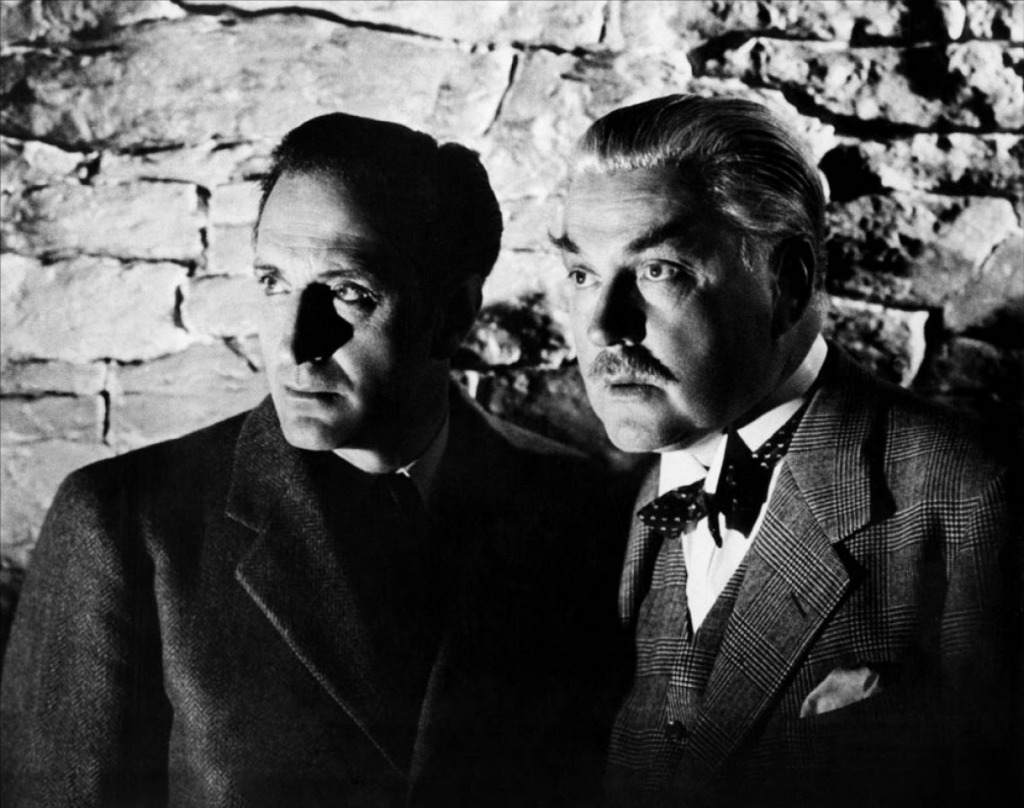
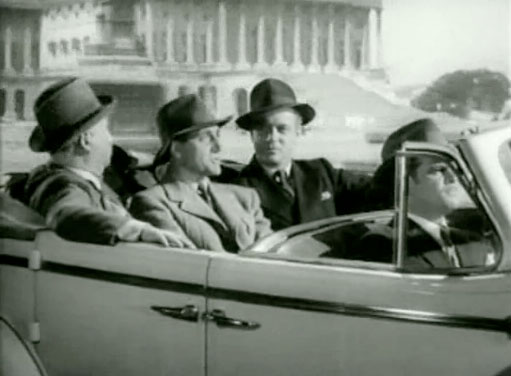
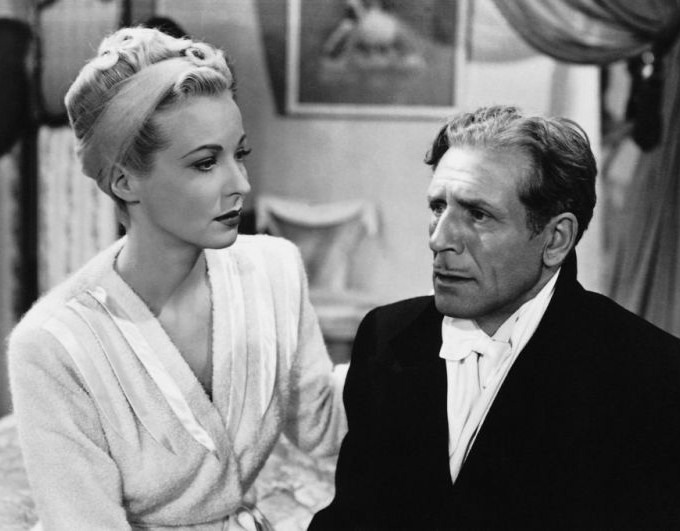
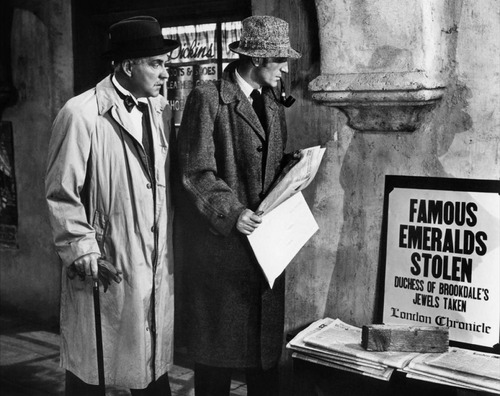

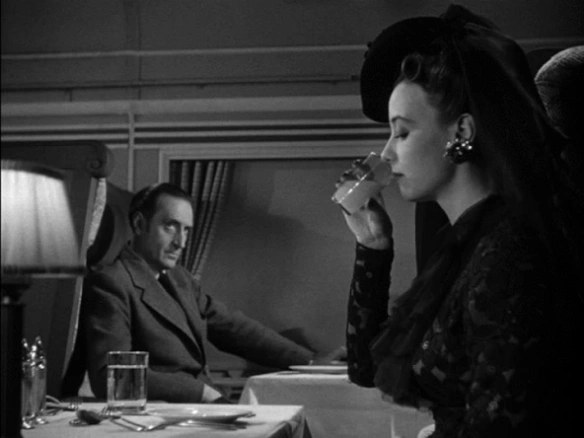
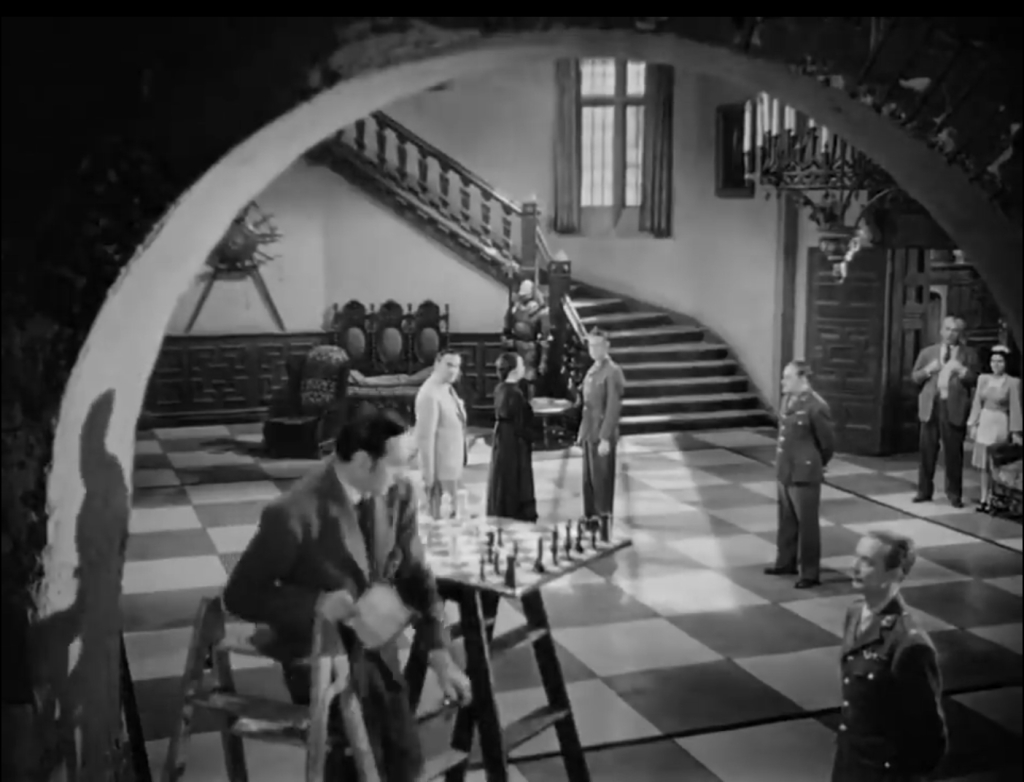
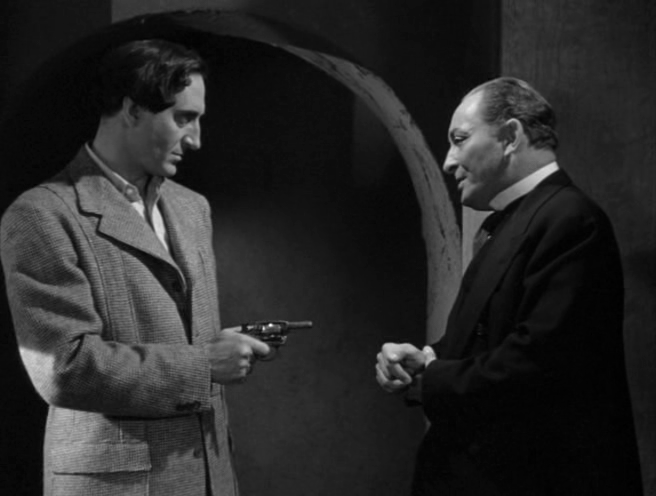
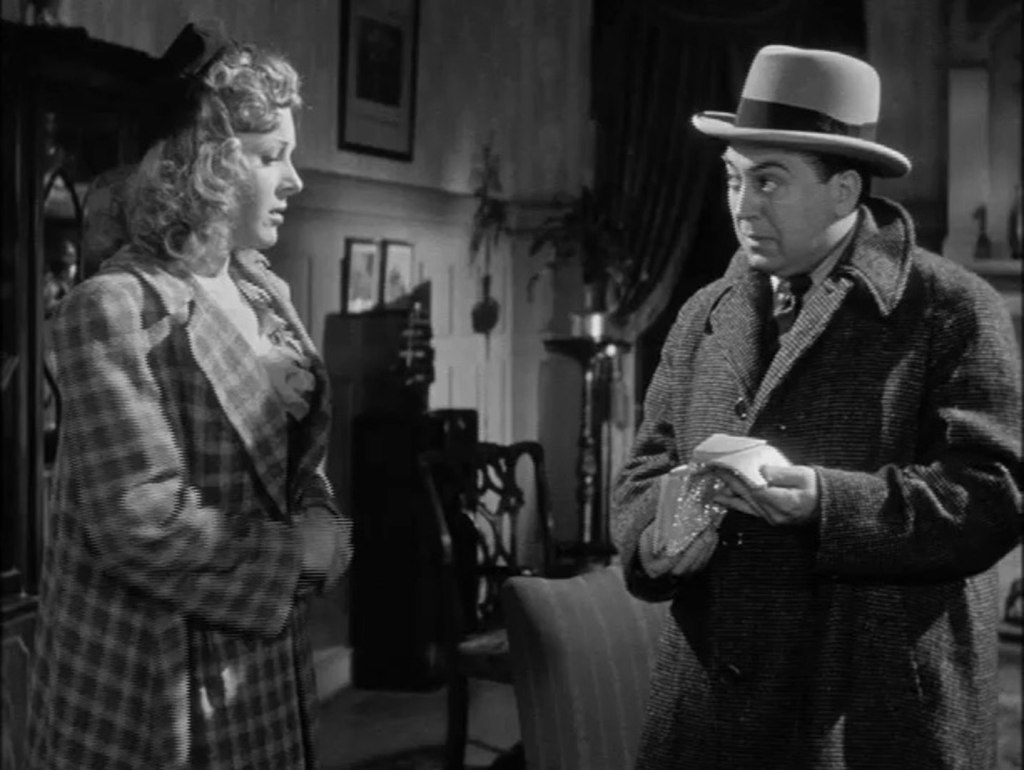
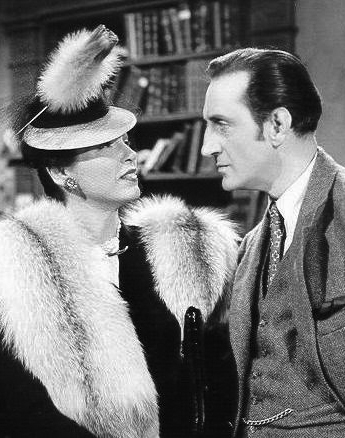
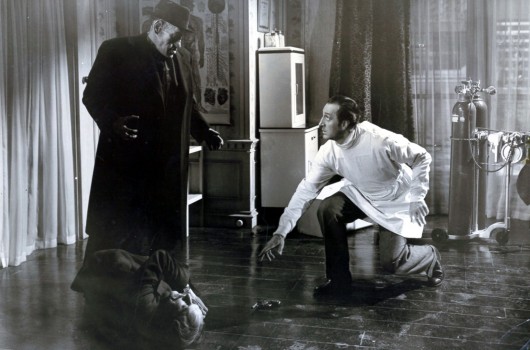
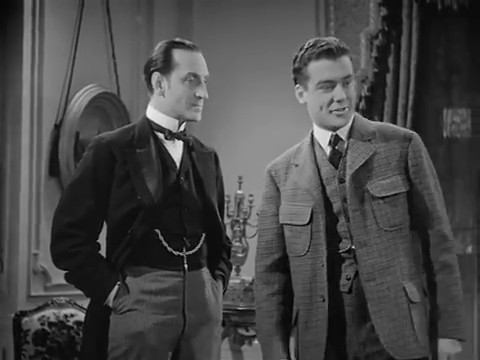
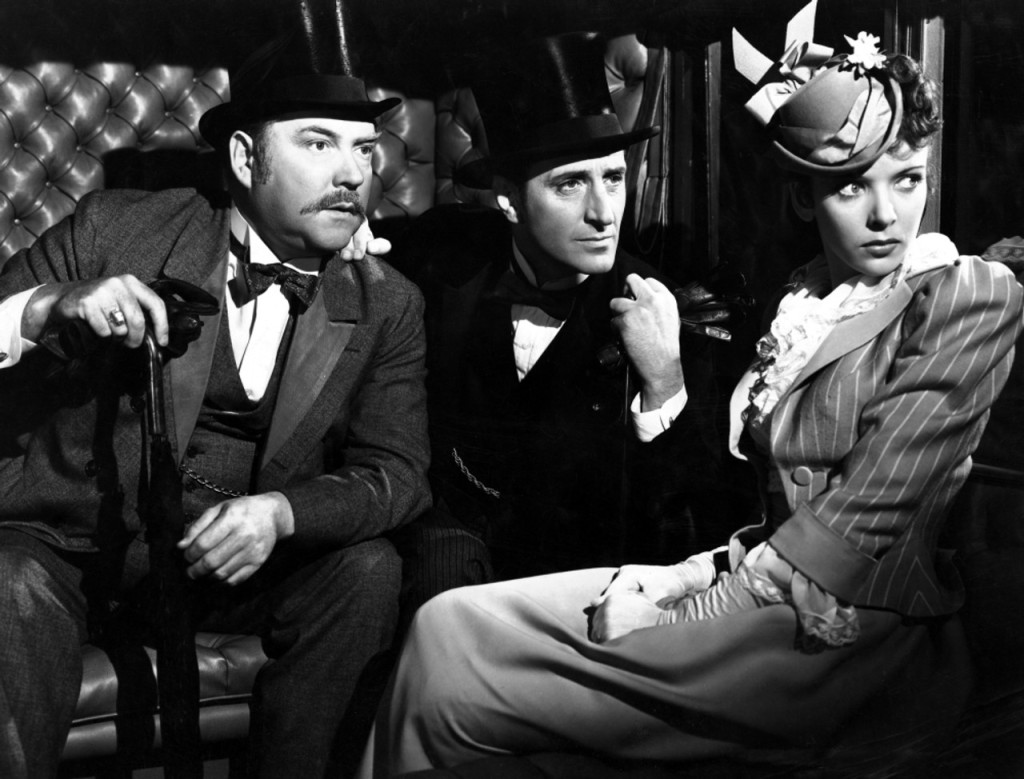


This was an incredibly fun draft – as were all of the drafts we did this year! I too hope that this prompts some readers to “reinvestigate” these films because, even when they prove to be weak mysteries, they are still fun, pulpy adventures.
As we said at the top of this draft, Rathbone would lay the groundwork for three-decades’ worth of other actors taking on the role of Sherlock Holmes and, until the character was retrofitted as a flawed anti-hero in the 1970s, Rathbone was the definitive representation of the Doylean character. Nigel Bruce certainly was not that for Dr. Watson, but he at least gave Watson something to do on film and made Holmes and Watson an inseparable duo forever after!
Looking forward to more drafts to come this year, gentlemen! (And in the meantime, Brad, I hope you use that new BritBox account to jump on the Jeremy Brett bandwagon!)
LikeLiked by 2 people
Brad –
Thanks for this great piece.
I’m a big Sherlock Holme fan – read all the books, and even the huge “Annotated Sherlock Holmes.” I’ve seen many (but not all) of the movies and TV treatments.
My (tangential) comment is that my favorite Holmes film is The Private Life of Sherlock Holmes, directed by Billy Wilder. Watch it if you haven’t already.
Keep up the good work.
John
LikeLike
I would agree about the Billy Wilder – even in its truncated form, it is by far my favourite Holmes movie.
LikeLike
That was great fun – thanks for being such a great host, Brad. It’s a splendid bunch of films and we were pretty much on the same page for at least 11 of them, which I think says a lot for our combined critical acumen. 😁 I think you may seriously love some of the BritBox content. As Nick says, the Brett series (especially the first two seasons, together with SIGN OF THE FOUR), is just superb.
Looking forward to the next challenge!!
LikeLike
Pingback: MY YEAR WITH BRITBOX: The Clergyman in the Cathedral with the Candlestick . . . | Ah Sweet Mystery!
Pingback: MY YEAR WITH BRITBOX: The Arrow Points to Sherwood | Ah Sweet Mystery!
Pingback: WHO’S AFRAID OF THE BIG GAD LIST? Announcing Our Next Draft | Ah Sweet Mystery!
Pingback: !TNEMECNUONNA DETREVNI NA (AN INVERTED ANNOUNCEMENT!) | Ah Sweet Mystery!
Pingback: MYSTERY MOVIE TALK: Three Announcements! | Ah Sweet Mystery!
Pingback: THE “GREATEST MYSTERY FILMS OF ALL TIME” DRAFT!!! | Ah Sweet Mystery!